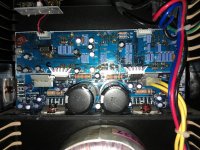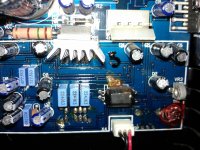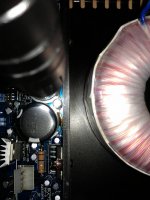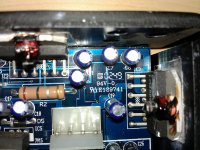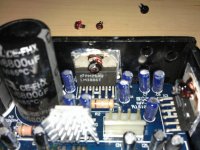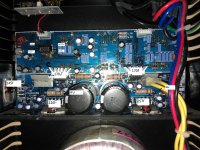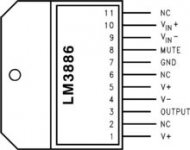One of my Behringer Truth B2031 Studio monitors has started overheating and making popping noises with no input at all. I am a fair hand at soldering but don't know enough about amplifier circuits to figure out what exactly is wrong.
The following are the speakers symptoms:
Speaker turns on and play music fine for roughly 20 minutes. It will play perfectly for about that time at any volume even quite loudly.
After 20 minutes of being on the speaker starts popping and the amplifier heatsink gets extremely hot to the touch. So hot you would not want to touch it for long, however will still play.
If you have no inputs connected to the amplifier it will still overheat and start popping the speaker after about 20 minutes.
If you disconnect the speakers and without any input connections it will still overheat, but of course no popping as there is no speaker connected.
I have attached pictures of the amplifier circuit board. I have focused on several areas that look like they might be troublesome. Please let me know if you have any other questions or tests you would like me to do. I have a good multimeter on hand if needed and can take pictures or video of anything.
I have searched the internet extensively for problems with this studio monitor and several people were having problem with the 7915 voltage regulators overheating. I attached small heatsinks to those just to see if it would help and it did not. I have found the replacement parts at Parts Express and will be replacing them anyway as they are only $1 a piece, and seem to be a trouble spot.
However please let me know if the capacitors need to be replaced or how to test them as they do not look blown as some capacitors ive seen on motherboards, but might be leaking? If they do need to be replaced, can you point me to the right replacement parts? Or better versions?
The following are the speakers symptoms:
Speaker turns on and play music fine for roughly 20 minutes. It will play perfectly for about that time at any volume even quite loudly.
After 20 minutes of being on the speaker starts popping and the amplifier heatsink gets extremely hot to the touch. So hot you would not want to touch it for long, however will still play.
If you have no inputs connected to the amplifier it will still overheat and start popping the speaker after about 20 minutes.
If you disconnect the speakers and without any input connections it will still overheat, but of course no popping as there is no speaker connected.
I have attached pictures of the amplifier circuit board. I have focused on several areas that look like they might be troublesome. Please let me know if you have any other questions or tests you would like me to do. I have a good multimeter on hand if needed and can take pictures or video of anything.
I have searched the internet extensively for problems with this studio monitor and several people were having problem with the 7915 voltage regulators overheating. I attached small heatsinks to those just to see if it would help and it did not. I have found the replacement parts at Parts Express and will be replacing them anyway as they are only $1 a piece, and seem to be a trouble spot.
However please let me know if the capacitors need to be replaced or how to test them as they do not look blown as some capacitors ive seen on motherboards, but might be leaking? If they do need to be replaced, can you point me to the right replacement parts? Or better versions?
Attachments
Last edited:
The LM3886T chips go from room temperature to about 107 degrees in the first 60 seconds. They then slowly climb at maybe 2 degrees per minute from there. However they never stop getting hotter. They eventually pass the 7915 in temperature and climb to 250+ degrees Fahrenheit, around which the popping starts.
I have modified a picture to show the temperature readings at which the popping starts.
The LM7915CT chip and the 7815 chip, which are known to go bad on these boards and the ones I put heatsinks on rapidly climb at a rate of about 1 degree every 5 secs until they get to 140 degrees and then slowly climb to 170 where they seem to stay.
I didn't know what you meant by output offset so I measured the voltages of the chipamps at first turn on and once they start popping. At start the pins I have identified in the picture are at 38v DC.
Once the popping starts the voltage changes rapidly between 34 and 39v DC. I could not detect varying voltages anywhere else.
What I believe are the PSU wires measure 30v AC (60mv DC) for each yellow wire and 0 for the brown. Once the popping starts the PSU voltages start jumping between 28 and 30 volts.
I don't know what you mean by check output offset, could you explain that for me?
I have modified a picture to show the temperature readings at which the popping starts.
The LM7915CT chip and the 7815 chip, which are known to go bad on these boards and the ones I put heatsinks on rapidly climb at a rate of about 1 degree every 5 secs until they get to 140 degrees and then slowly climb to 170 where they seem to stay.
I didn't know what you meant by output offset so I measured the voltages of the chipamps at first turn on and once they start popping. At start the pins I have identified in the picture are at 38v DC.
Once the popping starts the voltage changes rapidly between 34 and 39v DC. I could not detect varying voltages anywhere else.
What I believe are the PSU wires measure 30v AC (60mv DC) for each yellow wire and 0 for the brown. Once the popping starts the PSU voltages start jumping between 28 and 30 volts.
I don't know what you mean by check output offset, could you explain that for me?
Attachments
I don't know what you mean by check output offset, could you explain that for me?
Put your DC voltmeter on the speaker outputs of the 3886 and see if you get any DC (you shouldn't). Anything over 100mV is bad - though if the problem is like you described it's gonna be a lot more. It would also be wise to disconnect the woofer to prevent damage to it.
250 F is 120C - that's WAY hotter than an amplifier chip is supposed to run. The chips have probably gone bad if they get that hot. Are they screwed to the heatsink tight enough? 170 (77C) is alright for the 7815.
The output or pin 3 as I discovered on the schematic for the chip started with a dc voltage of 8mv on the hottest 3886 in my picture and slowly rose to 30.5mv DC
The output of the second hottest 3886 in my picture started at -12mv and rose to -35.2mv DC.
The output of the third stayed at 1.1mv the entire time.
They are all screwed in quite well with thermal paste in between them and the sink, and the entire heatsink gets very hot.
Also all measurements in this thread have been taken with no load (speakers) attached and no inputs attached. Let me know if you need any with a load.
The output of the second hottest 3886 in my picture started at -12mv and rose to -35.2mv DC.
The output of the third stayed at 1.1mv the entire time.
They are all screwed in quite well with thermal paste in between them and the sink, and the entire heatsink gets very hot.
Also all measurements in this thread have been taken with no load (speakers) attached and no inputs attached. Let me know if you need any with a load.
Attachments
Its looking like you may have parasitic oscillation in one or more of the LM3886 chips. 0.56A as a quiescent current is way beyond what would be expected for a no-signal condition. To check if this is the case, you'll need an oscilloscope. The third LM3886 doesn't seem to have a problem though.
Do you have a schematic?
Do you have a schematic?
I have searched everywhere but apparently Behringer does not release schematics and none have been posted on the net anywhere I could find.
I have an oscilloscope, how would I check for parasitic oscillation? I use multimeters quite often, however I only use my oscilloscope to check for square waves and so will need detailed instructions.
I have an oscilloscope, how would I check for parasitic oscillation? I use multimeters quite often, however I only use my oscilloscope to check for square waves and so will need detailed instructions.
After reading the manual for the lm3886 chip I realize where the popping is coming from. The chip has built in thermal protection that will shut itself off once it hits 165c and then start operating again once the temperature has dropped to 155c.
The chip driving the tweeter never overheats and so I get sound even though the other two chips are cycling.
So now I guess I need to figure out what is causing the overheating.
If it is an oscillation than I can just order two new lm3886 chips and I should be good to go correct?
The chip driving the tweeter never overheats and so I get sound even though the other two chips are cycling.
So now I guess I need to figure out what is causing the overheating.
If it is an oscillation than I can just order two new lm3886 chips and I should be good to go correct?
Just put your oscilloscope between ground and speaker output terminal and look for a high frequency sinewave. It's likely to be over 100kHz.
Though it is likely they simply went bad, and would not oscillate under normal conditions. New chips should fix it. Then find out why they overheat - if the heatsinking is inadequate that calls for some rework. Good old Berry always skimps on heatsinks.
Though it is likely they simply went bad, and would not oscillate under normal conditions. New chips should fix it. Then find out why they overheat - if the heatsinking is inadequate that calls for some rework. Good old Berry always skimps on heatsinks.
If it is an oscillation than I can just order two new lm3886 chips and I should be good to go correct?
Well changing the chips might fix up the symptoms of the disease but not address the cause. I've played with LM3886s and I've found they're quite hard to blow up when they're in a circuit that's basically functioning. So there might be some marginal layout (poor decoupling, too much track inductance somewhere) or sub-standard design which is leading to them overheating. Or another alternative is that what's driving them (opamps, active filters presumably) is oscillating and the chip amps themselves aren't at fault. That's why the oscilloscope is invaluable - to spot where the problem starts.
<edit> Do you know if the LM3886s are operating in bridged mode? This means the bass/mid drive unit is connected between the two outputs of the two (overheating) chips. The other alternative is they're paralleled, meaning the two outputs are connected together via some low value resistors.
<later edit> On examining the pics you've supplied (nice to get such hi-res shots!) it looks like they're using a couple of (0R1?) resistors and the amps are paralleled. So one thing to check is - lift one leg of one of the sharing resistors and see if the overheating still occurs.
Last edited:
Same problem
I have this same problem with my TRUTH B2031A. The only way to keep them on is to setup fans right behind each one. I'm hoping I can find a better solution to keep these things cool. Seems to me this design wasn't the greatest. I have had these for 5 years and have never had them operate without fans. Sadly I kept them in a closet for 3 straight years because of this.
I have this same problem with my TRUTH B2031A. The only way to keep them on is to setup fans right behind each one. I'm hoping I can find a better solution to keep these things cool. Seems to me this design wasn't the greatest. I have had these for 5 years and have never had them operate without fans. Sadly I kept them in a closet for 3 straight years because of this.
- Status
- This old topic is closed. If you want to reopen this topic, contact a moderator using the "Report Post" button.
- Home
- Amplifiers
- Chip Amps
- Need help fixing a 3886 based Behringer Studio Monitor amp!
